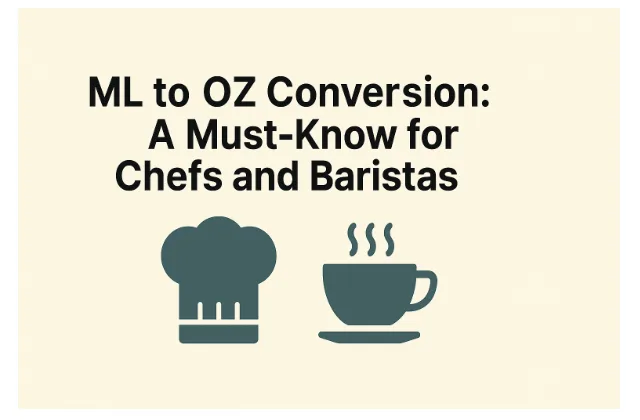ML to OZ Conversion: A Must-Know for Chefs and Baristas

Precision in measurement is one of the cornerstones of consistency in cooking, baking, and beverage preparation. Whether you’re a seasoned chef creating intricate sauces or a barista perfecting espresso ratios, knowing how to accurately convert milliliters (ml) to ounces (oz) is essential. Even a small measurement error can affect flavor, texture, and quality turning a perfect recipe into a failed experiment.
At Digital Calculator, we make conversions simple, accurate, and fast. With our ML to OZ Converter, you can calculate precise liquid measurements instantly ensuring every recipe, mix, or drink meets the exact standard you aim for.
Understanding ML and OZ: What Do They Mean?
Before diving into conversions, it’s helpful to understand what milliliters (ml) and ounces (oz) actually represent.
- Milliliter (ml): A metric unit of volume commonly used around the world. It’s part of the International System of Units (SI), where 1,000 milliliters equal 1 liter.
- Ounce (oz): A unit of volume used primarily in the United States. When referring to liquids, it’s known as the fluid ounce (fl oz).
Conversion Basics:
1 US fluid ounce = 29.5735 milliliters
1 milliliter = 0.033814 US fluid ounces
These conversions form the foundation of accurate liquid measurement especially in industries where precision matters.
Why ML to OZ Conversion Matters for Chefs and Baristas
Recipe Accuracy
Professional chefs and baristas rely on standardized recipes to maintain consistency. A dish or drink that tastes perfect one day should taste identical the next. Knowing how to convert ml to oz ensures that measurements remain consistent across kitchens, regardless of region or measuring system.
International Recipes and Menus
The culinary world is global. Many recipes written in Europe or Asia list ingredients in milliliters, while U.S. recipes often use ounces. A simple conversion can make an international recipe accessible, no guesswork required.
Beverage Craft and Mixology
Baristas, bartenders, and mixologists often work with syrups, espresso shots, milk, and water measured in varying units. A precise ML to OZ conversion ensures perfect proportions, preventing a coffee that’s too strong or a cocktail that’s too diluted.
Food Science and Consistency
For chefs who experiment or scale recipes, measurement conversions are fundamental to maintaining desired outcomes. Small miscalculations can alter the balance of acidity, sweetness, or texture especially in sauces, pastries, and emulsions.
The ML to OZ Conversion Formula
To manually convert milliliters to ounces, use the following formula:
Fluid Ounces (fl oz) = Milliliters (ml) × 0.033814
Examples:
- Convert 100 ml to ounces
100 × 0.033814 = 3.3814 fl oz - Convert 250 ml to ounces
250 × 0.033814 = 8.4535 fl oz - Convert 500 ml to ounces
500 × 0.033814 = 16.907 fl oz
Quick ML to OZ Conversion Table
| Milliliters (ml) | Ounces (fl oz) |
| 10 ml | 0.34 fl oz |
| 50 ml | 1.69 fl oz |
| 100 ml | 3.38 fl oz |
| 250 ml | 8.45 fl oz |
| 500 ml | 16.91 fl oz |
| 750 ml | 25.36 fl oz |
| 1000 ml (1 L) | 33.81 fl oz |
This table provides a quick reference for the most common conversions used in kitchens and coffee shops.
Practical Examples in the Kitchen and Café
For Chefs:
Imagine preparing a vinaigrette recipe written in ounces that calls for 2 fl oz of olive oil.
Using the conversion:
2 × 29.5735 = 59.15 ml
So, you’ll need about 59 ml of olive oil ensuring the perfect balance of oil to vinegar every time.
For Baristas:
Let’s say you need to pour 150 ml of steamed milk for a latte recipe that lists the milk in ounces.
150 × 0.033814 = 5.07 fl oz
Knowing this helps you keep your milk texture, foam ratio, and espresso balance consistent with every cup served.
Common Conversion Mistakes to Avoid
- Confusing Weight with Volume
Milliliters and ounces measure volume, not weight. Always use the correct unit depending on whether the ingredient is liquid or solid. - Using Imperial vs. US Fluid Ounces Incorrectly
- 1 US fl oz = 29.5735 ml
- 1 UK (Imperial) fl oz = 28.4131 ml
For accuracy, always check whether your recipe uses US or UK measurements.
- Rounding Too Early
When scaling recipes, rounding too early can lead to errors. Keep at least two decimal places in conversions for best results.
Why Use a Digital ML to OZ Calculator?
While manual formulas are useful, a Digital Calculator ML to OZ Converter saves time and eliminates mistakes. Simply enter the milliliter value, and the calculator instantly provides the accurate ounce equivalent.
Key Benefits:
- Instant, accurate results every time
- Supports both US and UK ounces
- Perfect for scaling recipes or converting large quantities
- Mobile-friendly and easy to use in kitchens or cafés
Conclusion:
Accurate measurement is the foundation of great food and beverages. Whether you’re steaming milk, mixing cocktails, or plating fine cuisine, understanding ML to OZ conversions helps you maintain the highest quality standards.Try our ML to OZ Calculator on Digicalc to make conversions effortless and precise.
